Movies and HDTV on a really big screen. Wow!
2006. My wife recently announced that it was time for us to get one of those large TV projectors. You could’ve knocked me over with a feather! I mean, this thing wasn’t even on my radar! Well, who am I to argue with her? I immediately did some research (before she could change her mind). 
First, a little background
We had recently been to the movies. I happened to comment that the previews and trailers were actually a video projection, not films. She took note of this, saying they didn’t look very good. I agreed but said that there are High Definition video projectors available that are really good. The feature started and that was that. Or, so I thought. About 2 weeks later, she made “The Announcement.”
Pictures
I quickly settled on the Optoma® HD7100, based primarily on reading other people’s opinions online. I got a pretty good price on it, plus a $400 rebate. I also purchased an electrically-operated screen, as we planned on hanging it from the living room ceiling in front of the fireplace, and we didn’t want it to forever hide the items Jen had lovingly arranged on the mantle. It seemed like the best thing to do was to have it automatically extend or retract when the projector was powered on or off. More on how that was done later (when I finish it).
The screen, a 16:9 Elitech® EH92MR2, measures 80” X 45”; it’s the equivalent of a 92” (diagonal) TV screen. Truthfully, it’s a little larger than I would have liked, and mounting it on the bottom of the beams wasn’t exactly what I had planned, but the next size smaller screen (which would have fit between the beams) really was quite a bit smaller, so we decided not to compromise. Besides, my wife loves it - good enuff for me!
Sounds
Of course, like the mountain man that bought his first TV and needed to put a roof on his shack so he had somewhere to put the antenna, we now needed an amplifier and speakers. We were replacing a 30” HD television and never had a stereo system in the living room. We purchased the Sony® STR-DG600 7.1 Home Theater Receiver. At about $250 street, this is not a really “high-end” amplifier, but it has plenty of power and features. I truly believe that, with today’s technology, amplifiers are like women; there are no bad ones, but some are better than others. (Kidding! Keep those cards and letters.) I also believe that the speakers are the weakest link in any sound system and, if you have to make a choice, that’s where you should put your money. So, with that in mind, we purchased a Bose AcoustiMass® 10 Series IV 5.1 Home Theater Speaker System. The combo is quite pleasing and it’s powerful enough to make your ears bleed without making you wish you hadn’t turned it up that loud in the first place. 
Media
For TV watching we have a DirecTV Plus® HD DVR (HR20). The all-digital pics from the satellite are superb - noise-free, ghost-free, studio-quality and, until recently, blows the doors off every cable system I’ve ever seen. (I should know - I’ve been a professional broadcaster since 1965. Read my thoughts on Digital TV here.) The connection from the satellite receiver to the projector is HDMI with a DVI adapter at the projector’s input. The audio connection from the DVR to the 5.1 amp is digital/optical (toslink).
Finally, rounding out the system is our Sony® DVD Player, the DVP-NS755V. Basically, this thing will play almost anything round (CD/DVD/SACD/MP3/5.1/etc). In addition to the digital/optical audio connection, it uses a discrete, 6-ch. audio connection to the amp for 5.1 audio when playing SACD. Although I haven’t connected it yet, I will probably connect the Sony VHS player at some point, too, as we have an extensive VHS collection. But, I’m not sure they’ll look that good on a 92” screen. VHS could get pretty grainy at that size!
Here are some pictures of my installation. The open ceilings of the post and beam construction of our old farmhouse actually made the job pretty easy.
Hanging the projector. Mounting the Speakers Note: These pix were taken prior to tinting the metal brackets with color similar to the beams, so they would stand out in the photos.
Mounting the Screen The picture you’ve been waiting to see! The installation isn’t finished - I’m writing this as I go along. There will be more pictures coming soon, as well as a detailed diagram of how it is all connected.
Update #1: Update #2: Meanwhile, I have been keeping busy making the installation a little neater. Here’s a few more quick photos.
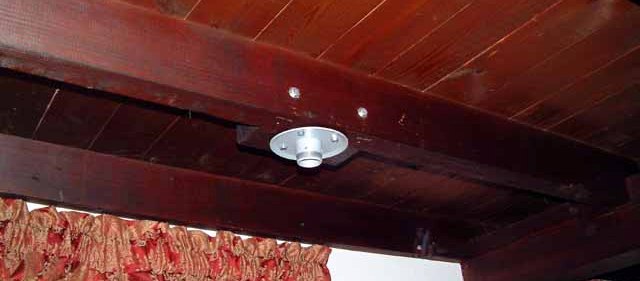
First, I widened the beam with a 4X4 to accommodate the ceiling mount flange.

The fixed portion of the mount is in place.
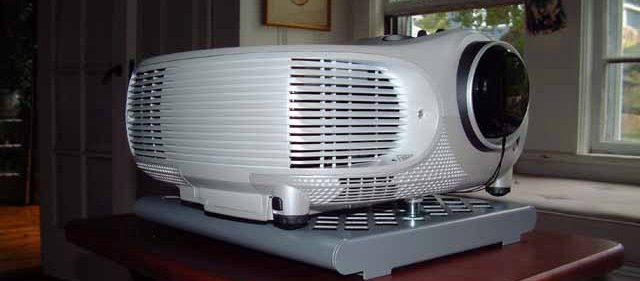
Shows the projector attached to the removable portion of the projector mount. The projector hangs upside down. Settings in the projector correct for this.
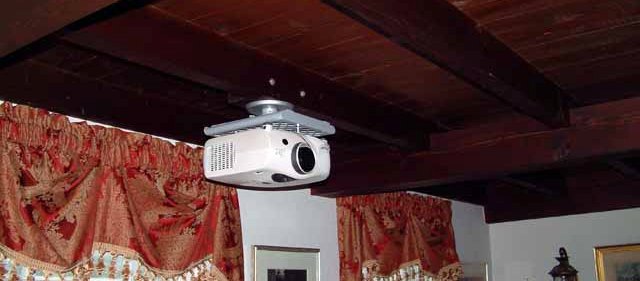
The projector is in place. The distance to the screen is approx. 10½ ft.
The Bose® speakers did not come with any mounting hardware - you’re supposed to buy appropriate mounts from them; wall/ceiling, table, or floor types. I didn’t like any of them (mostly because of the expense - the Bose® UB-20 wall/ceiling brackets are $30 each. That would have been an additional $150 just to hang 5 speakers!). So I made a quick trip to the local hardware store and made my own. Total cost to mount all 5 speakers? Under $13. See how I did it below.
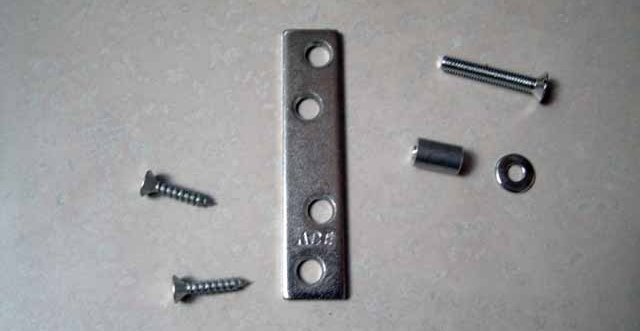
This is the hardware I used.
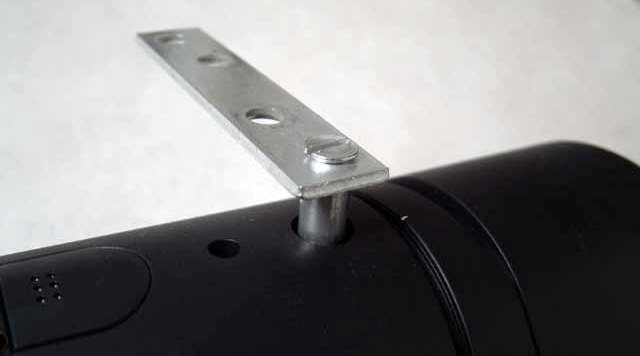
Detail of the hardware as assembled to the speaker.
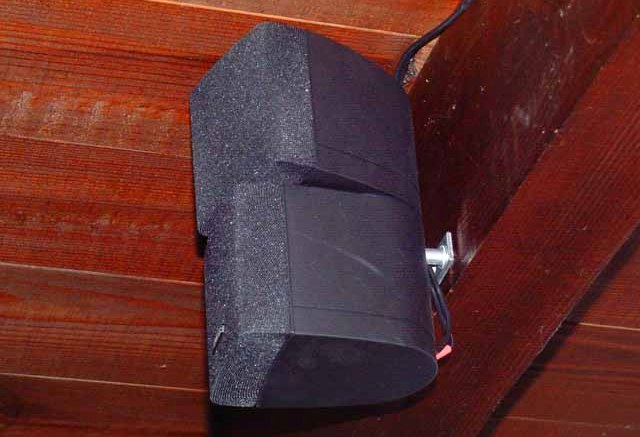
The left-front speaker is mounted on the front of a beam. The right-front, and both surround speakers are identically mounted.
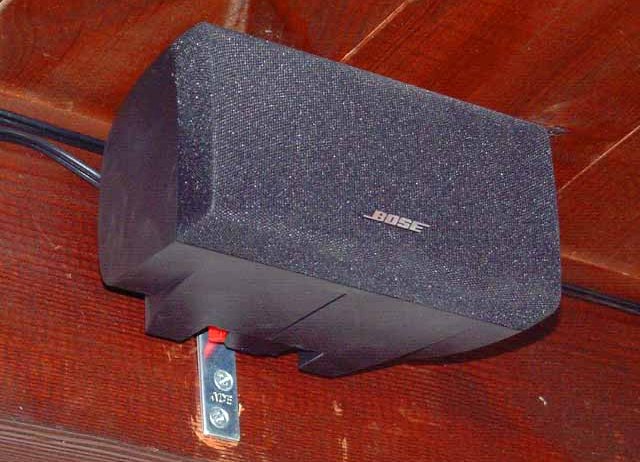
The center-front speaker, also mounted to a beam, is positioned directly above the center of the screen.
Because of the age of the house, I wanted a mounting system that would be a. Easy to use, b. Sturdy, and c. Allows me to level the screen. A simple arrangement of screw eye and turnbuckle made this easy. Note the closed-cell foam pads between the beam and the screen. This allowed me to level the screen yet have it snug to the beam in order to avoid any screen “sway”.
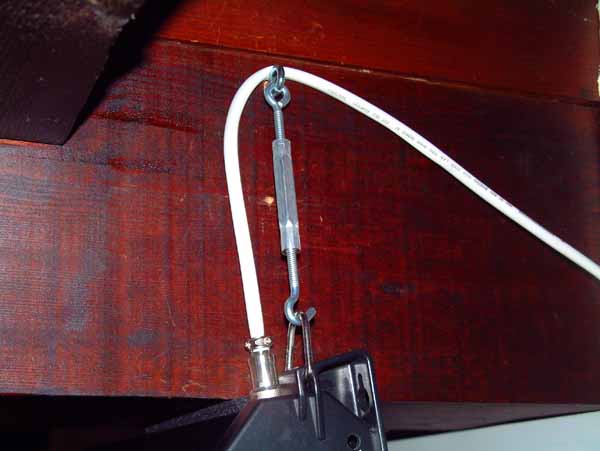
Detail view of screen mount.
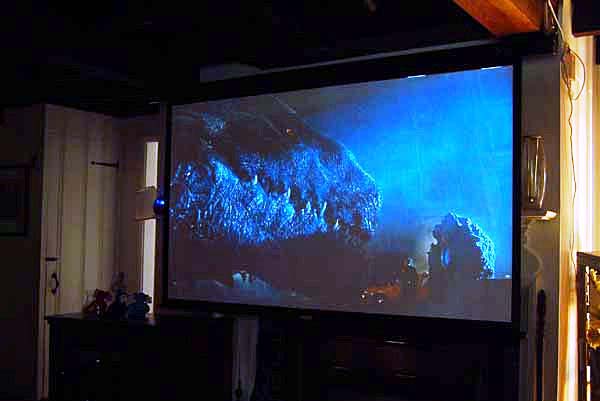
Taken in full daylight but with the window shades drawn.
Yesterday (10/21/2006) the lamp blew out! Totally bummed. It was only 6 weeks old and had 145 hours on it. I am SO happy I bought the extended 3-year lamp warranty. Now I get to see how good that is. I’ll post an update as soon as I have one.
I discovered today (11/3) that the vendor I bought the projector from gave me incorrect information re: the warranty return procedure for the defective lamp, so we are still watching the old 20” TV I brought down from the bedroom (we never watched it up there anyway). They told me to send it to the company that sold the extended lamp warranty (Mack Camera) but the lamp is still actually under the Optoma 90 day factory warranty and it should have been sent to them. So, I had to have Mack return the lamp to me so I could then send it out to Optoma in California. What a bummer! However, the people at Optoma couldn’t have been nicer or more helpful. What a relief that was!

I re-routed and covered the white screen power and control cables with black flex-tube because that’s the only color ½” tubing I had on hand. Perhaps someday I’ll get some ½” brown tubing.
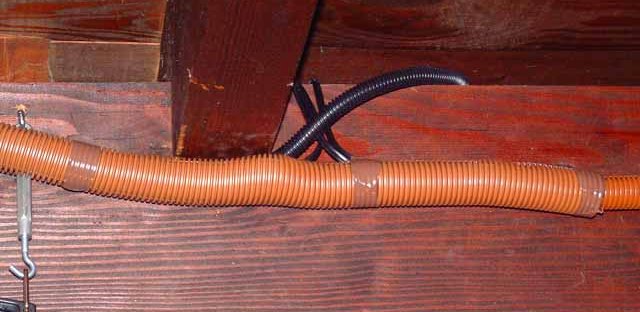
Brown flex-tube looks best against the dark brown wood. The 1” tubing covers the larger bundle of wires exiting the wall, then is reduced to ¾” for the rest of the run to the projector. I secured the tubing with brown vinyl electrical tape.
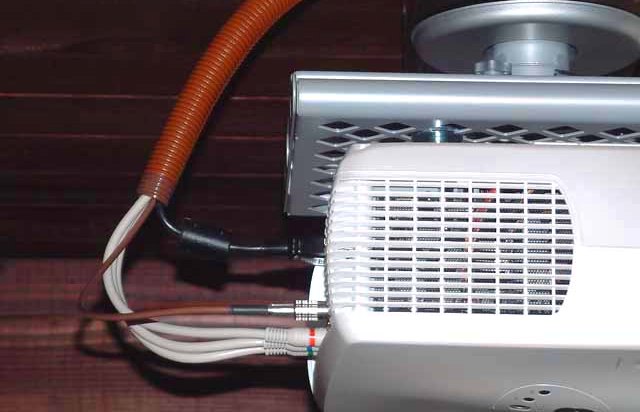
View of wires exiting the tubing behind the projector.